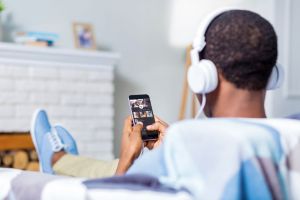|
www.HealthyHearing.com |
Hyperacusis, tinnitus, and sound tolerance: Finding relief from noiseDesensitization starts with calming the nervous system
Contributed by Glenn Schweitzer When you are highly sensitive to sounds, the world can become a scary place. 
For many hyperacusis and sound-sensitive patients, it’s like living with an unwanted form of super hearing, where certain sounds and frequencies (or possibly even all sounds and frequencies) become overwhelmingly loud, and in some cases, excruciatingly painful. Hyperacusis can take a heavy emotional and psychological toll on sufferers. In severe cases, sound sensitivity can completely destroy your quality of life all on its own. But hyperacusis is also a very closely related phenomenon to tinnitus, affecting around 40% of tinnitus sufferers. And when hyperacusis is compounded by bothersome tinnitus, it becomes even more challenging. The good news is that you can fully desensitize to all types of noise and find lasting relief from even the worst cases of sound sensitivity and hyperacusis, whether it’s accompanied by tinnitus or not. In my one-on-one tinnitus coaching practice, I have personally witnessed hundreds of sound sensitivity and hyperacusis sufferers find relief. In this column, I will break down the underlying connections between tinnitus, hyperacusis, and other similar conditions, as well as the most effective strategies for improving sound tolerance. Sound sensitivity, tinnitus, and the nervous systemAt the level of the nervous system, the problem of sound sensitivity looks extremely similar to the problem of tinnitus.
In the case of bothersome tinnitus, your nervous system essentially gets stuck in a vicious cycle of fight or flight, reacting more and more severely to the internal sounds of tinnitus. Whereas in the case of hyperacusis and sound sensitivity, your nervous system is stuck in a similar vicious cycle of fight or flight, but it’s reacting to external sounds and frequencies instead. There is actually a whole group of related sound tolerance conditions that all have a similar underlying mechanism where the nervous system gets stuck in an over-activated state. In addition to hyperacusis, sound sensitivity, and tinnitus, other sound tolerance conditions include:
In my work with patients, I have found that when a person is suffering from both tinnitus and one of these other conditions, they tend to flare up at the same time, and aggravate one another. But I have also found that all of these related sound tolerance conditions can be treated and improved in very similar ways, too.
Sound sensitivity and hyperacusis are caused by a variety of different health conditions and factors, many of which are treatable. But even if you are never able to identify or treat what caused your sound sensitivity, you can still desensitize to sound and restore your quality of life. Avoid becoming sound avoidantWith severe sound sensitivity, everyday noises can become scary, overwhelming, or even painful, and many patients do whatever they can to block and avoid sounds whenever possible. Blocking sounds with earplugs and over the ear hearing protectors can definitely reduce discomfort and help you feel better in the moment. But this strategy usually ends up making the problem worse, because your nervous system will continue to react negatively to quieter and quieter sounds, increasing your overall sound sensitivity. Of course, you should always protect yourself from dangerous levels of noise, but this gets tricky, too. With hyperacusis, just because a sound feels too loud or is triggering pain, doesn’t mean it’s actually loud enough to be causing hearing damage. 
clarity. Hearing protection is important, but if you take it too far and become sound avoidant, your sensitivity will likely start to increase. For most hyperacusis patients, the best option to reduce discomfort in day-to-day environments that are not loud enough to damage your hearing but still very uncomfortable is to get high-fidelity (musicians) earplugs. This allows you to reduce the decibel level of your surroundings, while still allowing you to hear clearly, just at a lower volume level. Meditation techniques for hyperacusis desensitizationIn my coaching practice working with patients, I primarily utilize a meditation-based strategy to help people reduce sensitivity to sound. I noticed early on that both the relaxation techniques and the tinnitus-focused-meditation techniques that I teach to help people to habituate to their tinnitus were also helping to improve sound sensitivity as a side effect. It would just slowly start to happen, almost every time, without the person having to do anything extra to increase sound tolerance. Desensitization, much like tinnitus habituation, takes time and calming the nervous system down is key. My tinnitus-focused-meditation techniques work well for this and are a powerful and effective strategy for hyperacusis who also have tinnitus. (For hyperacusis patients who do not have tinnitus, any consistent daily meditation practice will likely have a similar beneficial effect.) But for many patients, simply calming the nervous system with meditation and relaxation techniques is not enough. When sound sensitivity is severe, there are several meditative strategies that can help you increase sound tolerance overall, as well as decrease sensitivity to specific sounds and frequencies. Choosing a meditation styleBefore you attempt either of the following meditation strategies for sound desensitization, you need to decide what type of meditation you will be practicing. Most common meditative practices work well here – breath/body/mantra focused meditation, body scanning, and mindfulness meditation techniques can all be effective. Most of the people I work with are experiencing tinnitus and hyperacusis at the same time, and so I have my clients incorporate these strategies into tinnitus-focused meditation, though only once they are consistently able to get into a state of relaxation when meditating. Because meditation is such a calming mental exercise, if you successfully get into a meditative state of relaxation while listening to sounds that provoke your sound sensitivity, it retrains your nervous system to be calm in the presence of that sound and reduces sensitivity over time. Important note if you have never meditated beforeIf you have never meditated before, I do not recommend attempting either of the following meditation-based-desensitization strategies when first starting out. To get the most out of these desensitization techniques, you need to at least be able to consistently get into a relaxed/meditative state with more traditional meditation techniques, such as breath focused, body focused, mantra focused, or mindfulness meditation techniques. For those new to meditation, I highly recommend you learn and practice simpler (and easier) meditation techniques first before you attempt either of these strategies. Just having a consistent daily meditation practice will help to begin the desensitization process and will be a stepping stone to the more advanced desensitization strategies below. Meditation strategy to increase volume tolerance in general
your nervous system. Some hyperacusis patients are sensitive to all noise, rather than just specific sounds or frequencies, and need to increase their overall sound and volume tolerance across the board. When sound sensitivity is this severe, most patients will prefer to meditate in quiet environments, because it’s much easier for them to relax without background noise. But if you want to desensitize to sound, you need to actually expose yourself to sound in a controlled manner. The following strategy works as a sort of relaxed exposure therapy to increase volume tolerance. Step 1 – Find a tolerable background noise to play during meditation. Generally speaking, meditation music, nature soundscapes, and broadband sounds like white noise are the best options to explore. It can be difficult to find background noise or music that doesn’t completely trigger your sensitivity, but if you look hard enough, you can always find at least one or two options that work. Step 2 – Find the volume level you can tolerate with minimal discomfort. Once you find the background noise you are going to use, we need to set the volume properly. The goal here is to keep the volume level low overall, but just loud enough that it starts to ever so slightly provoke your sound sensitivity. For some patients, even one click of volume will be too loud. If this happens, you can use a Bluetooth speaker to play the sounds and move the speaker further away from you. Step 3 – Meditate at this volume level until it no longer triggers your sensitivity, then increase the volume one click, and repeat. It may be challenging to relax at all when first meditating with noise, even at these very low volume levels. But with practice it will become easier and easier. As soon as you are able to consistently relax at the current volume level, increase the volume one click and repeat. As your volume tolerance increases, you can start to incorporate other types of noise into your meditation practice. Meditation strategy to decrease sensitivity to specific sounds or frequenciesTo reduce sensitivity to specific sounds and frequencies, the strategy is similar to increasing volume tolerance, but with one important difference: Instead of meditating to comfortable background noise, you need to meditate to background noise that triggers your sound sensitivity and provokes an anxiety or emotional response. It can be very challenging at first, but you are in control of every part of the experience. Step 1: Decide what type of triggering sounds to use during meditation and find a way play these sounds consistently. First, you need to identify which sounds and frequencies trigger your sound sensitivity the most, and way to play those sounds during meditation. Interestingly, you can find many different types of uncomfortable sounds by searching on YouTube. Search for whatever type of sound that triggers you followed by “Sound therapy.” For example, let’s say you are triggered by the sound of motorcycles, you would search “motorcycle sound therapy.” If you are triggered by plates or silverware clinking, search for “restaurant sound therapy.” Step 2: Set the volume to the lowest level possible When first incorporating difficult sounds into your meditation sessions, start with the lowest possible volume level, and keep it the same every time. If you are using an audio track, this is easily done by controlling the volume on your phone or computer or moving further away from the speaker. If you are meditating with the sound of your refrigerator, or any other environmental noise, simply move further away from the source of the sound. Step 3: Meditate at this volume level until it no longer triggers your sensitivity, then increase the volume one click, and repeat. Once you are completely comfortable meditating at the current volume level, increase the volume until it begins to provoke your sensitivity again, and repeat. When you have fully desensitized to the current background noise, you can move on to a different type of triggering noise and begin the process again. Sound therapy for hyperacusis desensitizationIn addition to meditation, sound therapy and sound masking can also be extremely helpful for sound sensitivity, but the strategy is bit different from using sound therapy for tinnitus masking. With hyperacusis and sound sensitivity, when you hear a triggering noise in silence, it will always provoke a more intense reaction in the nervous system. It can almost feel like a physical hit to the body. The most effective strategy is to use much quieter volume levels for than you would for tinnitus sound therapy, simply as a way to keep the auditory system activated at all times. This kind of low volume sound therapy acts as a buffer, lessening the nervous system response in the moment, which will help you to desensitize to sounds, over time. The challenge is finding the right kinds of sound to use for sound therapy when you are highly sensitive to noise. Some patients find broadband sounds, such as white noise helpful, but others might be highly sensitive to these frequencies of noise and would only end up reacting negatively to the sound therapy. When severe tinnitus and hyperacusis occur together, it can become very difficult and time consuming to find the comfortable sound therapy sounds, and the right volume levels to actually help with both problems. But it’s always possible. My advice here is to just keep trying as many different types of sounds and volume levels as it takes until you find options that actually work for you. I’ve never seen a single case where a person couldn’t find at least one or two options that worked well. You just have to keep looking. It may take time, but relief is possibleIt’s important to remember that hyperacusis desensitization takes time, even with the best available techniques. All of the strategies mentioned here require repetition and time to increase your sound tolerance. But relief is entirely possible, and that is all that matters. You can actively work to desensitize to all triggering sounds and restore your quality life. Even if the world sounds scary right now, it doesn’t have to be that way for much longer. Glenn Schweitzer
|
Featured clinics near me
Earzlink Hearing Care - Reynoldsburg
7668 Slate Ridge Blvd
Reynoldsburg, OH 43068

Find a clinic
We have more hearing clinic reviews than any other site!


.png)
 Glenn Schweitzer is an entrepreneur, blogger, and the author of Rewiring Tinnitus and Mind over Meniere’s. He is passionate about helping others who suffer from tinnitus and vestibular disorders and volunteers as an Ambassador Board Member for the Vestibular Disorders Association (VEDA). Through his blogs, he continues to raise awareness for tinnitus, Meniere’s disease, and other vestibular disorders, spreading his message of hope to those in need.
Glenn Schweitzer is an entrepreneur, blogger, and the author of Rewiring Tinnitus and Mind over Meniere’s. He is passionate about helping others who suffer from tinnitus and vestibular disorders and volunteers as an Ambassador Board Member for the Vestibular Disorders Association (VEDA). Through his blogs, he continues to raise awareness for tinnitus, Meniere’s disease, and other vestibular disorders, spreading his message of hope to those in need.